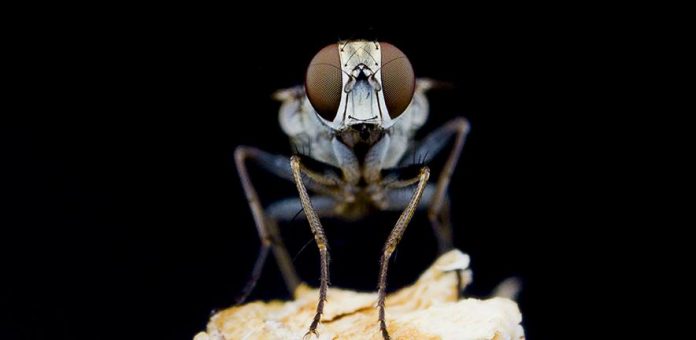Killer flies can reach accelerations of over 3g when aerial diving to catch their prey – but at such high speeds they often miss because they can’t correct their course.
These are the findings of a study by researchers at the Universities of Cambridge, Lincoln, and Minnesota, published in the Journal of the Royal Society Interface.
Killer flies (Coenosia attenuata) perform high-speed aerial dives to attack prey flying beneath them, reaching impressive accelerations of up to 36 m/s2, equivalent to 3.6 times the acceleration due to gravity (or 3.6g). This happens because they beat their wings as they fall, combining the acceleration of powered flight with the acceleration of gravity.
This is an impressive feat: diving Falcons, the fastest animals that predate in the air, achieve much lower accelerations of only 6.8m/s2. Falcons dive by folding their wings and simply letting gravity accelerate them towards their prey.
For the tiny Killer fly though, the high speeds achieved in aerial dives could come as a surprise – because the researchers think the fly doesn’t take the effect of gravity into account when diving to intercept a target.
To get their results, the researchers built a transparent ‘flight arena’ and flew a dummy prey target through it at constant velocity. Killer flies were filmed with high speed video cameras as they attacked the target, and the researchers watched the footage back in slow motion – using this data to reconstruct the entire attack sequence in 3D.
The study found that Killer flies reached much higher accelerations in flight when taking off from the ceiling of the arena, compared to from the floor or walls. The flies beat their wings at a similar rate wherever they launched from, indicating that their flight speed is determined by a combination of wing power and gravity.
“When Killer flies took off from the floor or walls of the arena, they moved at the time when they could take the shortest path to the target. But they couldn’t manage that when they took off from the ceiling because the high acceleration caused by gravity changed the expected flight path,” said Sergio Rossoni, a PhD student in the University of Cambridge’s Department of Zoology and first author of the paper.
By diving with super-high acceleration the Killer fly sometimes catches its target prey extremely quickly, but it often misses because its speed makes it challenging to change course mid-dive if the prey moves. But even if the fly doesn’t land on target, the dive quickly reduces its distance from the prey so it can keep sight of it while making the final manoeuvers to catch it.
The researchers think the effect of not accounting for gravity during downward dives might be compensated by another advantage. High speed dives force the potential prey to change direction as the attacker approaches, but to do this the prey has to slow down – making it easier to catch.
Insects that hunt in the air usually attack their prey upwards, because the contrast of the prey against the sky makes it easier to see. Killer flies are unusual insect predators in this respect; hunting downwards against a visually cluttered ground, using eyes that have only coarse resolution, is more difficult.
“This research into miniature flies helps us understand what shortcuts are acceptable when survival depends on fast decisions and accurate actions, but the sensory capabilities and processing power of the predator are heavily constrained,” said Professor Gonzalez-Bellido at the University of Minnesota, who led the study.
This research was funded by the Air Force Office of Scientific Research, the Biotechnology and Biological Sciences Research Council and the Royal Society.















